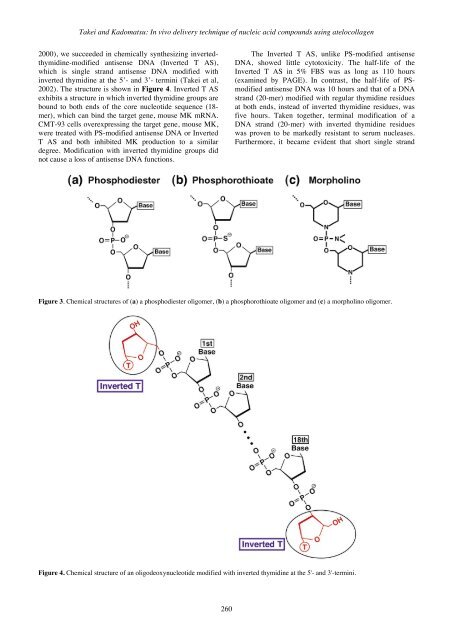In vivo delivery technique of nucleic acid compounds using ...
In vivo delivery technique of nucleic acid compounds using ...
In vivo delivery technique of nucleic acid compounds using ...
You also want an ePaper? Increase the reach of your titles
YUMPU automatically turns print PDFs into web optimized ePapers that Google loves.
Takei and Kadomatsu: <strong>In</strong> <strong>vivo</strong> <strong>delivery</strong> <strong>technique</strong> <strong>of</strong> <strong>nucleic</strong> <strong>acid</strong> <strong>compounds</strong> <strong>using</strong> atelocollagen<br />
2000), we succeeded in chemically synthesizing invertedthymidine-modified<br />
antisense DNA (<strong>In</strong>verted T AS),<br />
which is single strand antisense DNA modified with<br />
inverted thymidine at the 5’- and 3’- termini (Takei et al,<br />
2002). The structure is shown in Figure 4. <strong>In</strong>verted T AS<br />
exhibits a structure in which inverted thymidine groups are<br />
bound to both ends <strong>of</strong> the core nucleotide sequence (18mer),<br />
which can bind the target gene, mouse MK mRNA.<br />
CMT-93 cells overexpressing the target gene, mouse MK,<br />
were treated with PS-modified antisense DNA or <strong>In</strong>verted<br />
T AS and both inhibited MK production to a similar<br />
degree. Modification with inverted thymidine groups did<br />
not cause a loss <strong>of</strong> antisense DNA functions.<br />
260<br />
The <strong>In</strong>verted T AS, unlike PS-modified antisense<br />
DNA, showed little cytotoxicity. The half-life <strong>of</strong> the<br />
<strong>In</strong>verted T AS in 5% FBS was as long as 110 hours<br />
(examined by PAGE). <strong>In</strong> contrast, the half-life <strong>of</strong> PSmodified<br />
antisense DNA was 10 hours and that <strong>of</strong> a DNA<br />
strand (20-mer) modified with regular thymidine residues<br />
at both ends, instead <strong>of</strong> inverted thymidine residues, was<br />
five hours. Taken together, terminal modification <strong>of</strong> a<br />
DNA strand (20-mer) with inverted thymidine residues<br />
was proven to be markedly resistant to serum nucleases.<br />
Furthermore, it became evident that short single strand<br />
Figure 3. Chemical structures <strong>of</strong> (a) a phosphodiester oligomer, (b) a phosphorothioate oligomer and (c) a morpholino oligomer.<br />
Figure 4. Chemical structure <strong>of</strong> an oligodeoxynucleotide modified with inverted thymidine at the 5'- and 3'-termini.
















